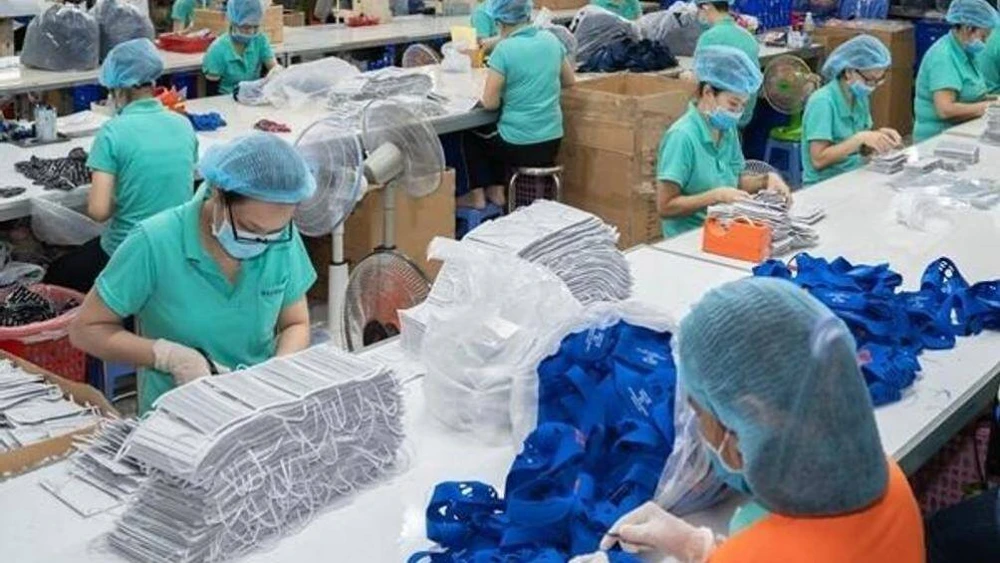
Lost opportunities
The first quarter of 2020 was quiet and unpredictable, pervaded by a gloomy business scenario and slowed production. The outbreak of the Covid-19 pandemic raged across the world, disrupting flow of raw material supplies, freezing some markets and causing shortage of labor and capital deficit to cover costs of production. However, by the beginning of the second quarter, domestic textile enterprises saw a glimmer of hope when the demand for face masks in several countries increased phenomenally to cope with the spread of the disease.
According to the European-American Market Department in the Ministry of Industry and Trade, from the beginning of April, many countries in Europe and America began to import face masks and protective equipment for individuals and for those serving the population of countries struggling to contain the pandemic. For example, the US market has demand for about 500 million N95 medical face masks, 200 million face masks of all other types, 1,000 ventilators, 1 billion pairs of gloves, 100 million sets of medical robes, and 50 million sets of protective clothing. Other markets such as Spain, Kazakhstan, Canada and Russia too are in need of face masks and medical protective equipment.
According to Mr. Truong Van Cam, Vice Chairman and General Secretary of the Vietnam Textile and Apparel Association (Vitas), Europeans and Americans are changing their behavior, and now are using more face masks on a daily basis. This demand is steadily increasing. This is motivation enough for textile enterprises to restructure production and shift to making face masks to meet a new international demand. The Vietnam Chamber of Commerce and Industry (VCCI) believes this short-term opportunity could help save Vietnamese textile and garment enterprises in the current bleak scenario.
In mid-April, the Vietnamese Government agreed to export medical face masks, protective clothing and medical equipment, only after ensuring a sufficient stock reserve to meet domestic demand. With this export opportunity, about 15% of top textile enterprises began a face mask production line and some small businesses or outsourcing businesses are also taking advantage of this market to maintain production, retain workers and actively link to find output for other products.
Overlap in regulations
However, in reality, the export of face masks has not been smooth sailing for textile enterprises. Several export regulations are hindering the supply and the barriers include the Ministry of Health not being organized to bid for buying masks, and no specific announcement has been made about whether or not the reserves for domestic use have been purchased. According to the Ministry of Industry and Trade, the supply capacity of textile enterprises is for almost eleven million face masks per day. The paradox is that due to an overlap of regulations between the ministries, exports have been held back.
It is not just the export of masks that are being weighed down under regulations, but the export of rice too is facing the same fate since early April. In early May, the Government agreed to export rice, but this is also the time when countries in the region such as Thailand and India enter the harvest season, and rice prices in the world market begin to cycle down when supply begins to stabilize. The enterprises exporting Vietnamese rice have no more price advantage in the market now.
This setback of overlap in policies for the export of goods is not new for Vietnamese enterprises and domestic exporters have complained about these unreasonable regulations to regulatory authorities for last many years. According to Asso. Prof. Dr. Nguyen Duc Thanh, former Director of Vietnam Institute for Economic and Policy Research (VEPR), shortcomings in rice export regulations have shown an overlap of policies as well as inconsistencies in the centralized administration of the Government.
Mr. Thanh said that the National Reserve Department itself or any State agency, when participating in the market, must have market thinking and accept the happenings and principles of the market. He also commented that the current quota we are applying for export enterprises is relatively old and outdated. Therefore, the current problem is to balance the consumption volume and production volume and only when it is sufficient we must allow exports.
Data from the General Statistics Office of Vietnam shows that Vietnam's export turnover in April was around USD 19.7 bn, down 18.4% compared to March and down 3.5% over the same period in 2019. In general, exports of most commodities have decreased compared to March. In this context, the export goods that are in high demand in the world market and also the goods that Vietnamese enterprises have strength over, such as masks and rice, are not much. This is also a commodity group that is expected to be a bright spot in the gloomy picture of exports due to the negative impact of the Covid-19 pandemic.
However, overlap of export regulations has slowed down export activities, causing businesses to miss opportunities to grab market share advantages.




















